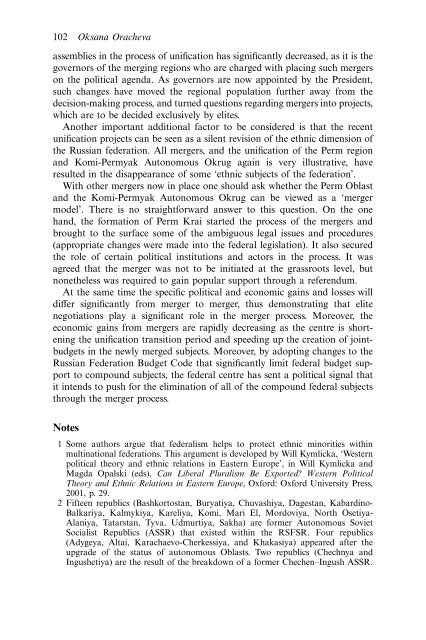Federalism and Local Politics in Russia
Federalism and Local Politics in Russia
Federalism and Local Politics in Russia
Create successful ePaper yourself
Turn your PDF publications into a flip-book with our unique Google optimized e-Paper software.
102 Oksana Orachevaassemblies <strong>in</strong> the process of unification has significantly decreased, as it is thegovernors of the merg<strong>in</strong>g regions who are charged with plac<strong>in</strong>g such mergerson the political agenda. As governors are now appo<strong>in</strong>ted by the President,such changes have moved the regional population further away from thedecision-mak<strong>in</strong>g process, <strong>and</strong> turned questions regard<strong>in</strong>g mergers <strong>in</strong>to projects,which are to be decided exclusively by elites.Another important additional factor to be considered is that the recentunification projects can be seen as a silent revision of the ethnic dimension ofthe <strong>Russia</strong>n federation. All mergers, <strong>and</strong> the unification of the Perm region<strong>and</strong> Komi-Permyak Autonomous Okrug aga<strong>in</strong> is very illustrative, haveresulted <strong>in</strong> the disappearance of some ‘ethnic subjects of the federation’.With other mergers now <strong>in</strong> place one should ask whether the Perm Oblast<strong>and</strong> the Komi-Permyak Autonomous Okrug can be viewed as a ‘mergermodel’. There is no straightforward answer to this question. On the oneh<strong>and</strong>, the formation of Perm Krai started the process of the mergers <strong>and</strong>brought to the surface some of the ambiguous legal issues <strong>and</strong> procedures(appropriate changes were made <strong>in</strong>to the federal legislation). It also securedthe role of certa<strong>in</strong> political <strong>in</strong>stitutions <strong>and</strong> actors <strong>in</strong> the process. It wasagreed that the merger was not to be <strong>in</strong>itiated at the grassroots level, butnonetheless was required to ga<strong>in</strong> popular support through a referendum.At the same time the specific political <strong>and</strong> economic ga<strong>in</strong>s <strong>and</strong> losses willdiffer significantly from merger to merger, thus demonstrat<strong>in</strong>g that elitenegotiations play a significant role <strong>in</strong> the merger process. Moreover, theeconomic ga<strong>in</strong>s from mergers are rapidly decreas<strong>in</strong>g as the centre is shorten<strong>in</strong>gthe unification transition period <strong>and</strong> speed<strong>in</strong>g up the creation of jo<strong>in</strong>tbudgets<strong>in</strong> the newly merged subjects. Moreover, by adopt<strong>in</strong>g changes to the<strong>Russia</strong>n Federation Budget Code that significantly limit federal budget supportto compound subjects, the federal centre has sent a political signal thatit <strong>in</strong>tends to push for the elim<strong>in</strong>ation of all of the compound federal subjectsthrough the merger process.Notes1 Some authors argue that federalism helps to protect ethnic m<strong>in</strong>orities with<strong>in</strong>mult<strong>in</strong>ational federations. This argument is developed by Will Kymlicka, ‘Westernpolitical theory <strong>and</strong> ethnic relations <strong>in</strong> Eastern Europe’, <strong>in</strong> Will Kymlicka <strong>and</strong>Magda Opalski (eds), Can Liberal Pluralism Be Exported? Western PoliticalTheory <strong>and</strong> Ethnic Relations <strong>in</strong> Eastern Europe, Oxford: Oxford University Press,2001, p. 29.2 Fifteen republics (Bashkortostan, Buryatiya, Chuvashiya, Dagestan, Kabard<strong>in</strong>o-Balkariya, Kalmykiya, Kareliya, Komi, Mari El, Mordoviya, North Osetiya-Alaniya, Tatarstan, Tyva, Udmurtiya, Sakha) are former Autonomous SovietSocialist Republics (ASSR) that existed with<strong>in</strong> the RSFSR. Four republics(Adygeya, Altai, Karachaevo-Cherkessiya, <strong>and</strong> Khakasiya) appeared after theupgrade of the status of autonomous Oblasts. Two republics (Chechnya <strong>and</strong>Ingushetiya) are the result of the breakdown of a former Chechen–Ingush ASSR.
















